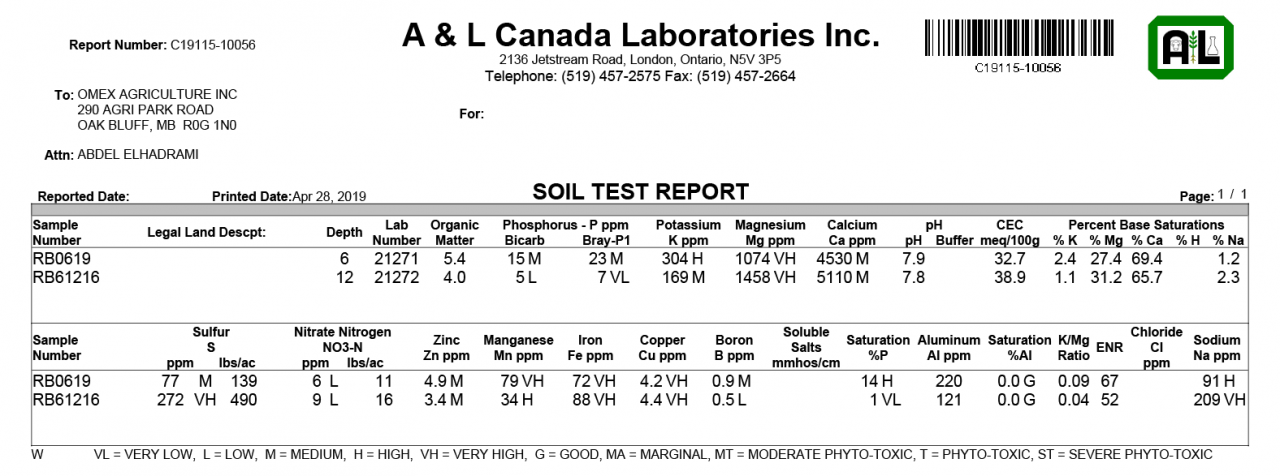Soil Testing: What Should You Look For?
In the pursuit of better and bigger crops, farming is becoming more technologically advanced and capital intensive. The need to find ways to save money, while continuing to reach for those high yield goals, is more important than ever for Canadian producers. If this sounds like a conundrum that you’re facing, soil testing might be the answer.
 Soil testing allows budgeting for the optimal fertility per crop and location, by providing a snapshot of the residual level of essential nutrients such as nitrogen, phosphorus, potassium, sulfur, calcium and magnesium, as well as micronutrients (boron, copper, zinc, manganese, iron and molybdenum). It’s not a crystal ball, but a complete soil test can provide you with a glimpse into the challenges to be expected in each field for the coming season.
Soil testing allows budgeting for the optimal fertility per crop and location, by providing a snapshot of the residual level of essential nutrients such as nitrogen, phosphorus, potassium, sulfur, calcium and magnesium, as well as micronutrients (boron, copper, zinc, manganese, iron and molybdenum). It’s not a crystal ball, but a complete soil test can provide you with a glimpse into the challenges to be expected in each field for the coming season.
Soils have large amounts of the essential nutrients needed by plants, but only a small fraction (often less than 1 per cent) is in a form that is readily available for uptake. A soil test typically indicates that availability by measuring only the portion of the total pool of nutrients available for uptake. The release of these nutrients from the non-available state into the readily available form involves complex physical, chemical and microbiological processes in the soil.
Soil Test Basics: Understanding the Numbers
It’s important to note that differences among analytical laboratories may exist due to variations in soil properties from one geographic region to another, the use of different extracting reagents and the application of different methods to interpret the results. However, estimations of the amount of nutrients required to optimize plant growth and yield potential are always calibrated to the method used.
Here’s what your soil test can tell you:
pH: The first important parameter on a soil test is pH. Soil pH measures hydrogen (H) ions in soil and typically ranges between 5.5 and 8.0. The ideal pH for a crop to grow is 6.5–6.8.
- When soil pH is less than 5.5, the soil is very acidic and likely has high levels of aluminum and/or iron, alongside lower content of calcium and magnesium. Low pH reduces availability of nutrients such as phosphorus and molybdenum, affects nitrogen fixation and causes crop toxicity with elements such as aluminum or manganese that become more soluble at a lower pH. Soil liming may be necessary when the pH is less than 6.0. Additionally, root growth can increase by 40% when pH rises from 5.5 to 7.2.
- When soil pH is greater than 8.0, availability of nutrients like phosphorus or metal micronutrients can be reduced and soil pH greater than 8.3 can indicate high sodium or sodic soil problems and often drainage issues. Elemental sulfur may be required on these soils especially if they are high in magnesium.
Base Saturation (BS): This represents the ratio of five nutrients: potassium (ideal range: 3–5%), magnesium (10–20%), calcium (60–80%), hydrogen (<10%) and sodium (<1%). If the sum of potassium, magnesium and calcium is higher than 80%, the land has a high potential for growing crops.
Cation Exchange Capacity (CEC): These parameters measure the capacity of the soil to hold or absorb positively charged elements called cations, some of which are plant nutrients. The major soil cations include calcium (Ca2+), magnesium (Mg2+), potassium (K+), sodium (Na+), hydrogen (H+) and aluminum (Al3+). The higher the number, the more water and nutrients that can be held and exchanged by the soil. For instance, with a CEC of 15, a soil can hold and exchange 150 lbs of nitrogen. CEC is strongly affected by soil texture and increases as soil clay content increases.
Organic Matter (OM): Soil OM represents the humus resulting from plant and animal residues that have decomposed. OM is an important reservoir for nutrients in organic forms, which break down and mineralize to release available nutrients to the crop. Soil OM also improves the physical condition of the soil including tilth, structure and water infiltration. The typical ranges of OM are 2–3% for brown soils, 3–5% for dark brown soils, and 6-10% for black soils. The OM for gray soils ranges from 2–4%.
Finally, the soil test report will also include a read of the level of macro-, secondary- and micro-nutrients in the 0-6” and in the 6-12” (mainly nitrate and sulfate). These are important to develop a comprehensive fertility program that responds to the crop grown based on the targeted yield. In acidic soil, one should pay attention to the levels of iron and aluminum in conjunction with calcium and magnesium; aluminum and iron hinder the availability of phosphorus and cause root injuries.

Interpreting the Results: OMEX Can Help
When you understand your soil test reports, you are in a better position to develop an appropriate fertility program for each crop you are growing and the OMEX team is here to help.
The Plant Health Professionals at OMEX are well-trained to help you read and analyze your soil test and, working with your agronomist and Ag retailer, your rep can advise on a good soil and foliar fertility program. Based on your soil test results, your rep will recommend products that will help you grow healthy crops with a full yield potential, including Primers to coat the seed, Starters to strategically place phosphorus in-furrow with the seed, and Foliars that are tank-mixable with your pesticide sprays. We also offer water conditioners, plant growth regulators, biologicals and many individual micronutrients that correct deficiencies when they occur in the field or prevent them before they occur.
To get this season off to the best start possible, talk to your local Ag retailer or get in touch with your OMEX representative today.
